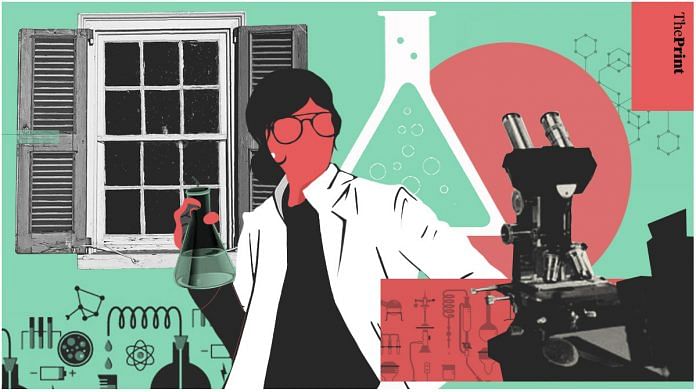Almost every year, newspaper headlines in India proclaim the superior performance of girls over boys in that annual rite of passage before college – board exams. This story seems to capture the imagination of readers and the press alike.
Yet, few of us wonder why these bright young girls rarely seem interested in pursuing one of the most important fields shaping our world today – science.
While the number of women opting for science in higher education has shown a gradual increase in recent years (All India Survey on Higher Education 2018–19), we do not see a corresponding rise in women entrants to ‘science workplaces’ or research and development (R&D) institutions.
Here is a simple test to illustrate the challenge: If asked to name a famous Indian woman scientist, would you have a ready answer? Interviews and focus group discussions show that most tend to struggle. Thereby hangs a tale. Where are the gutsy girls of Indian science?
Also read: Lack of support, not ‘likeable’ — why India doesn’t have more women in science
Bring in the role models
Most girls decide on the subjects they want to study between the ages of 13 and 17, and Grade 10 is when this choice of subjects is formalised within the school system. Schools and boards thus need to upscale efforts to educate girls about the opportunities that Science, Technology, Engineering and Mathematics (STEM) offer.
Concomitantly, teachers and parents have a crucial role to play in fighting popular stereotypes – that STEM subjects are tough and demand a special intelligence, or that science is the exclusive preserve of male geniuses.
An important way to inspire young schoolgirls is to present them with the right role models. That is what the Indian Ministry of Women and Child Development did in 2020 when they recognised 11 trailblazing women scientists who had overcome all odds to achieve success. Their stories present a unique opportunity to begin a conversation with young girls about how they too could work towards rewarding careers in STEM.
In a similar attempt to build awareness about Indian women scientists and leaders, UNESCO works with the Wikimedia Foundation to help create Wikipedia profiles of a broad spectrum of women achievers in science and other fields.
The ongoing battle against the coronavirus has also seen pathbreaking contributions from women scientists like K. Sumathy and Nita Patel. Sumathy, who leads R&D at Bharat Biotech, was instrumental in the development of Covaxin, India’s first indigenous Covid vaccine. And Patel – the head of vaccine development at American biotech firm Novavax – oversaw the development of Novavax’s Covid-19 vaccine. Their stories present a unique opportunity to begin a conversation with young girls about how they too could work towards rewarding careers in STEM.
The UNESCO study ‘Cracking the Code: Girls’ and Women’s Education in STEM’ (2017) notes that only 35 per cent of STEM students in higher education are women, with further gender disparities within scientific disciplines.
These concerns about the gender gap in STEM are shared by the Indian Department of Science and Technology (DST). Indeed, the DST has launched a series of schemes to galvanise women’s participation in science at multiple levels, and to empower women scientists. Globally too, programmes like the L’Oreal–UNESCO ‘For Women in Science’ initiative support and promote women at different stages of their scientific careers.
Also read: I talked to and met Indian women in science for years. And this is what they told me
Instilling an interest in science
At the school level, however, the challenge is twofold. How do we nurture our girls to develop an abiding interest in science? And how do we encourage them to recognise the merits of pursuing higher studies, and eventually careers, in STEM-related fields?
As a first step, a process for systematically sharing stories of women scientists across schools could be put in place. This could include workshops, gatherings of science clubs, or group mentoring sessions. Second, high-visibility inter-school science quizzes, Olympiads and scholarships for girls could help build a groundswell of interest in STEM.
Teachers may themselves need to be further trained to instil a scientific temper in students, and particularly to stimulate an interest in science among girls. Teacher-training institutes could focus more closely on these elements as they build the capacity of early- and mid-career teachers.
Finally, India’s transformative National Education Policy 2020 emphasises the need for activity-based and experiential learning. This opens up a host of opportunities for school systems to devise new methods for fostering girls’ aptitude for science.
As India marches into a new decade, let us work together to ensure that girls realise their fullest potential. Let us enable them to say, like theoretical physicist Bindu A. Bambah: “I never had as much fun with science as I had during my school years, thus when the choice of a career course was to be made I knew I wanted to study science.”
Eric Falt is the Director and Representative of the UNESCO New Delhi cluster office covering Bangladesh, Bhutan, India, the Maldives, Nepal and Sri Lanka. Ilina Singh is a high school science student promoting Women in Science, Technology, Engineering and Mathematics – STEM. Views are personal.
(Edited by Neera Majumdar)



